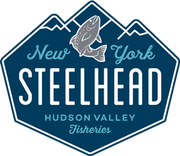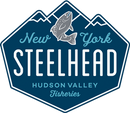Rural Intelligence

New York Steelhead, "Salmon's Tastier Cousin," Now Farmed Locally And Sustainably
By: Jamie Larson
Because of its outward appearance and rich, orange-red flesh, steelhead is often confused for salmon, but the fish is actually a trout species native to the West Coast. Now the tasty fish, not commonly found on this side of the country, is popping up in Hudson Valley restaurants, grocery stores and farmers markets as Hudson Valley Fisheries (HVF) rolls out waves of steelhead from their indoor fish farm just outside of Hudson, New York.
If you’re having déjà vu, don’t worry — the New York Steelhead facility by HVF is the former home of the failed Local Ocean fish farm, which collapsed in 2012 when the Israeli-based owners disappeared, leaving scores of unpaid back taxes and tanks full of Mediterranean species of fish.
Thankfully, this already looks to be a much more positive story. While HVF is owned by the multinational recycling outfit Fortune Group, the company is owned by the self-made Ng family, who started out in the '70s with just a scrapyard in The Bronx.
HVF spokesperson Heidi Raker said company CEO John Ng and his family have always been concerned about food scarcity. Their research brought them to the decision that aquaculture in the Hudson Valley would provide high-quality, sashimi-grade, super-fresh product quickly to all major Northeastern cities. HVF also recently became the first New York State Grown and Certified aquaculture company.
"Hudson Valley Fisheries established roots in Hudson because of the area's association with artisanal food, purity and quality," said Ng upon receiving the designation. "This was a choice we are very satisfied with for a variety of reasons beyond the cache of the Hudson Valley. It enables us to maintain a small carbon footprint in terms of Northeastern delivery, and to leverage sophisticated restaurant relationships where chefs care deeply about sustainably and responsibly sourced ingredients.”
HVF purchased the former Local Oceans facility in 2014 and totally refurbished the structure and rebuilt the Recirculating Aquaculture Systems (RAS). They produced their first harvest in 2015 and have been selling, primarily downstate, ever since, stocking Gadaleto’s, Hudson Valley Seafood, and Fairway Markets at a rate of $12 a pound in the suburbs and $14 in cities. While they are only providing fish to a few restaurants in the Rural Intelligence region (Fish & Game and Gaskins) Raker said they are now eager to make relationships with local grocers and more restaurants. They also have a stand at the Kingston Farmers Market if you’re willing to cross the bridge.
“Obviously, people love wild-caught fish,” said Brittany Peachey, HVF aquaculture operations manager. “But RAS has advantages beyond sustainability. One big advantage is we have control over our water source so there’s no need for antibiotics or vaccines."
Though you may not have heard of it until now, Hudson Valley Fisheries is already the largest RAS facility in America, currently nearing its production goal of 50,000 pounds of product a week. The industry is taking notice, not just of their production levels but also their commitment to reducing ecological impact.
"Hudson Valley Fish Farms is Best Choice-rated by The Monterey Bay Aquarium Seafood Watch, a program that helps consumers and businesses choose seafood that's fished or farmed in ways that support a healthy ocean, now and for future generations," Ng added. "Our RAS facility was designed to keep our carbon footprint small. Michael Timmons, Cornell College of Agriculture and Life Sciences Professor in the Department of Biological and Environmental Engineering, consulted with us on the most advanced technology to create a natural habitat environment for our fish and also enable us to serve as an aquaculture teaching facility. We are producing sashimi-grade, top-quality steelhead trout with mindfulness around food security, minimal environmental impact, and sustainable seafood production."
HVF’s ambitions in the region don’t stop at fish. On the 120-acre farm the company purchased behind the fishery, they are now growing their first test crop of hemp and have plans to begin growing produce, as well. All that fish waste makes for excellent fertilizer.
Past experiences with aquaculture in the Hudson Valley have been decidedly mixed, but as more people get a taste of New York Steelhead, the company won't have to worry about swimming upstream.










